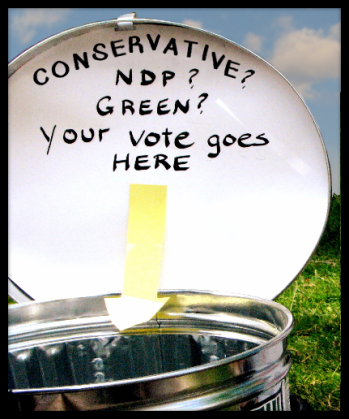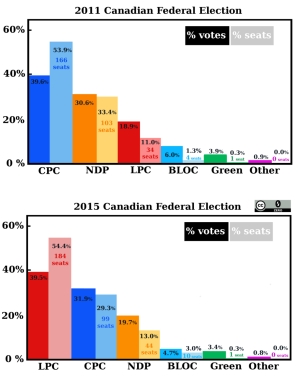![]()

I’m a Canadian. Like many I come from settler stock… my paternal ancestors emigrated to Canada before confederation (although my paternal grandmother didn’t arrive until the 1920’s), and my maternal ancestors fled the Russian Revolution. My husband’s family emigrated from the Netherlands in 1967.
I have always been happy to be Canadian, and Canada is a pretty good country to live in. The problem is that instead of getting better, far too much has gotten worse over the course of my lifetime.
 Citizen Engagement
Citizen Engagement
When I was in high school, I wrote letters to Perrin Beatty, my local MP. And I was blown away when he called me to discuss my issues. So that’s how I thought it was supposed to work. But it’s different now. If a letter mailed to MPs or MPPs might elicit a response, it generally comes months later, and is far more likely to be a form letter than anything that actually responds to what I’ve written.
The issues that have bothered me throughout my adulthood never seem to get better; they’ve just multiplied. It isn’t that I’ve given up, but my voting has never made any difference. It took me a long time to understand that the fundamental problem is that although Canada is a representative democracy, it isn’t very representative.
] YukoAfter voting in every election for more than 30 years, no one I have ever voted for has ever been elected to Parliament. Or Queen’s Park. Our representative democracy certainly has not represented me.
Whenever I vote, I cast my vote for the candidate I think will best represent my interests in Parliament. It’s not that I only vote for fringe parties, I have voted for all the majors at one point or another. What I started noticing is the candidates and parties that actually listen to citizens are those with no hope of getting elected this time. When winning a majority becomes a possibility, they stop listening to us and instead+=() 90start telling us.
Naturally, off and on over the years I’ve been upset enough to join the odd protest in hopes of convincing this government or that to listen. But that too has rarely worked.
Voting has always been a futile exercise for me, so I was teetering on the brink of giving it up. Except… I’m a mother. Didn’t your mother ever tell you the sign of a good guest is to leave a place better than you found it? In opp an alarming number of ways, the Canada of today is much worse than the Canada I started with, and frankly, that isn’t the Canada I want to leave to my son, or any of the generations to follow.
Meaningful Electoral Reform 
Many people think the act of casting a ballot makes for democracy. But I’ve been doing it my whole life and it it has never resulted in representation in Parliament. The problem in Canada is that some votes count more than others, while most don’t count at all. So it’s no wonder so many people give up on voting. Why waste your time doing something so pointless? Defenders of the status quo insist that all is well with our First Past The Post electoral system because all our votes are counted.
“But just because my vote is counted does not mean it counts.”
Which is why I was on the verge of giving up myself, until I discovered our FPTP winner-take-all system isn’t the only democratic system. This is difficult for us because it’s the only way most of us have any familiarity with. Our system is based on the UK Westminster Parliament and although there are significant differences, the American presidential model of goverment is also a winner-take-all system. More formally known as “majoritan/plurality,” electoral systems that only allow for a single winner are “winner-take-all.” Elections in Canadian electoral districts result in a single winner. This winner only rarely wins a majority of votes, because s/he only needs to win the most votes. In a 5 candidate race that might mean as little as twenty something percent of the votes cast.
Our current majority Liberal government was elected with 39.5% of the votes cast by Canadians. This government replaced a majority Conservative government elected with 39.6% of the vote. The net result is that a majority of Canadians did not vote for the party that won all the power. A majority of Canadian votes didn’t count. The reality is that more eligible Canadian voters did not vote at all than voted for the Liberal Party (or the Conservative Party before them).
But this isn’t the way it has to be. We don’t have to settle for winner-take all politics, there are different kinds of voting systems that result in Proportional Representation. All that means is that 39% of the votes will only deliver 39% of the power in Parliament. Although this may surprise you as much as it did me, the reality is 90+ countries use some form of Proportional Representation.
And we could too.
It’s easy for Canadians to to get confused by the different factors because we have little or no experience with Proportional Representation. But if we are ever going to be able to solve the most important problems we face we really need to adopt some form of Proportional Representation. Since Canadians have given the Liberal Government an actual mandate to replace our unfair winner-take-all First Past The Post system following consultation with Canadians, it is incredibly important for us to become informed so we can achieve the meaningful electoral reform we need.
Although I’m not an expert, over the last few years I’ve been learning a lot about Proportional Representation. Over the next months I will do my best to share what I’ve learned with you. There’s so much to cover, so I plan on posting a new article in the series at least once a week (on Fridays) but more if I have time. If Canada is to truly be a Representative Democracy, we all need representation.
Resources
I’ll be putting together a resources page in the sidebar, but to get you started, Fair Vote Canada is a multi-partisan grass roots organization that advocates for Proportional Representation.
I’ve been putting together an Electoral Reform Playlist of videos in YouTube you may find helpful.

• Proportional Representation for Canada
• What’s so bad about First Past The Post
• Democracy Primer
• Working for Democracy
• The Popular Vote
• Why Don’t We Have PR Already?
• Stability
• Why No Referendum?
• Electoral System Roundup
• When Canadians Learn about PR with CGP Grey
• Entitlement
• Proportional Representation vs. Alternative Vote
• #ERRÉ #Q Committee
• #ERRÉ #Q Meetings & Transcripts
• Take The Poll ~ #ERRÉ #Q
• Proportionality #ERRÉ #Q
• The Poll’s The Thing
• DIY Electoral Reform Info Sessions
• What WE Can Do for ERRÉ
• #ERRÉ today and Gone Tomorrow (…er, Friday)
• Redistricting Roulette
• #ERRÉ submission Deadline TONIGHT!
• #ERRÉ Submission by Laurel L. Russwurm
• The Promise: “We will make every vote count” #ERRÉ
• FVC: Consultations Provide Strong Mandate for Proportional Representation #ERRÉ
• PEI picks Proportional Representation
• There is only one way to make every vote count #ERRÉ
• Canada is Ready 4 Proportional Representation
• Sign the Petition e-616
• #ProportionalRepresentation Spin Cycle ~ #ERRÉ
• International Women’s Day 2017 ~ #IWD
• An Open Letter to ERRÉ Committee Liberals
and don’t forget to check out the PR4Canada Resources page!


Well done, great article.
Thank you. 🙂
Great to hear it kept simple so anyone can understand the concept.
I,m all for it, great article !!!! MMP for Me.
There’s definately a lot to learn about this topic.
I love all the points you’ve made.
Just one problem: our system is NOT Majoritarian. In a majoritarian system, a candidate has to win more than 50% to win a seat. Examples are Alternative Vote and instant run-off. In our system, a candidate can win with less than 50%, which makes our system a Plurality system.
This is one of the most common mistakes about electoral systems. I see it repeated in newspaper articles on a regular basis. Another popular misconception is that “ranked ballot” is a system, when in fact it’s a type of ballot that can be used in either a Majoritarian or a Proportional system.
Unfortunately, these mistakes are not harmless. The first leads to people thinking our system is better than it is. Polls find that many people wrongly believe that a candidate needs to get 50% or more of the vote to win in our system. The second leads people to assume that Ireland’s system is not proportional, and therefore to undercount the number of countries that have PR.
If we are ever going to get a decent electoral system in this country, we’ll need to stop the spread of misinformation about PR and start getting the facts out.
Fair enough: I’ve changed it from “majoritan” to to “majoritan/plurality.”
I’ve edited:
More formally known as “majoritan,” electoral systems that only allow for a single winner are “winner-take-all.”
to
More formally known as “majoritan/plurality,” electoral systems that only allow for a single winner are “winner-take-all.”
Even so, while each MP is elected with a plurality, our “majority” governments consist of an actual majority of seats in Parliament (albeit plurality seats).
Just so you know, I am not an expert, just a frustrated citizen who has learned a great deal about this and is still learning. This article was written a bit more than a year ago, and I wouldn’t make this mistake today. I have unvested a great deal of time and energy to this and I strive for accuracy. If you catch any further errors, please let me know.